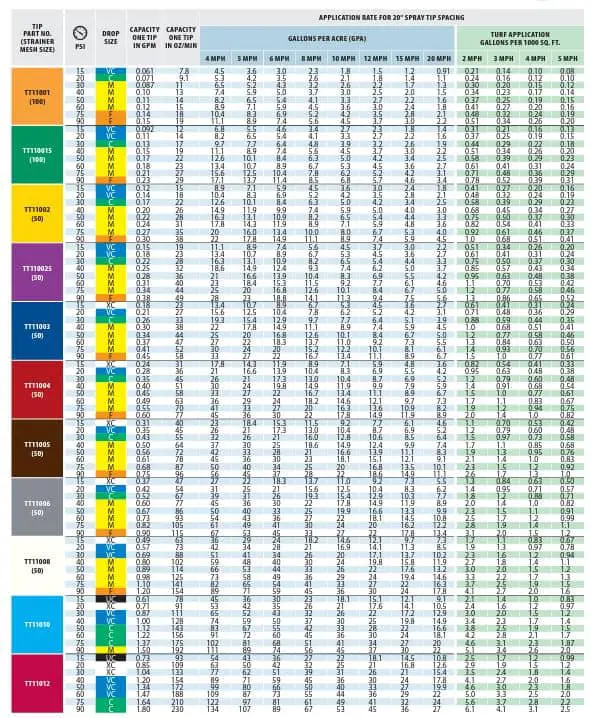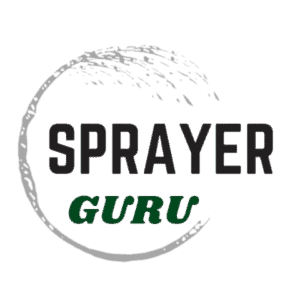Sprayer Nozzles look like simple components and if you are a beginner you might think that they are mostly interchangeable. However, the sprayer nozzle is an extremely important piece of a sprayer. They actually have more impact on the overall results you get from your herbicide, pesticide, etc., than any other single item on your sprayer.
So how then do you distinguish one nozzle from another? Sure some are designed differently and there are different colors, but how will you know how each individual type of nozzle will perform just by looking at it?
The answer is you don’t, at least not the whole picture. You can glean some info from the nozzle appearance but to understand the complete performance and the attributes of a sprayer nozzle you need to look at the spray nozzle chart.
What is a Spray Nozzle Chart?
A spray nozzle chart is a table that displays all the performance data of a given type of sprayer nozzle. It contains information that shows the characteristics of that nozzle. Knowing how to read one is the key to selecting the right spray nozzle.
The primary purpose of spray nozzle charts is to help applicators make informed decisions when choosing a sprayer nozzle. Nozzles determine the flow rate, droplet size, spray pattern, and overall distribution of the liquid that is being sprayed.
In the spraying world, two fundamental factors stand out as critical drivers of success: flow rate and droplet size. These two variables have a profound impact on the outcome of your sprayer’s application and effectiveness.
Flow Rate & Nozzle Size
Flow rate refers to the volume of liquid that a nozzle delivers per unit of time. In the US when talking about agricultural, de-ice, lawn care, or any other type of boom sprayer, the nozzle flow rate is displayed in gallons per minute.
Spray nozzles come in different sizes to accommodate different flow rates. The different sizes are listed on the left-hand column in a spray nozzle chart. Depending on the type of nozzle, the different sizes are typically color coded. In the case of tapered flat fan nozzles that are used on boom sprayers, the nozzle sizes and color code is universal. If you are unfamiliar with the color code for sprayer nozzles, then be sure to read my article which explains the nozzle color code and nozzle size in detail.
How Do I Know What Size Nozzle I Need?
The nozzle size you need is determined by calculating the gallon-per-minute flow rate needed from a nozzle at your desired operating pressure. The gallon per minute you need is based on the application rate you need to disperse over your field or yard. The application rate in agriculture is typically expressed in gallons per acre or GPA. For yards/lawns, it might be gallons per 1000/sq feet.
All of this can be a bit confusing but there is a simple formula to use to figure out the nozzle size you need. You need to know the speed at which you will spray, the space between each nozzle on your boom, and the gallon-per-acre rate you need to apply. The gallon per acre rate will be something that your pesticide or herbicide label will provide guidance on, or you can consult your chemical rep or agronomist.
To determine your nozzle size, you would use this formula:
Flow rate (GPM) = (Gallons per acre x Speed (MPH) x Nozzle width) / 5940
The number that you come up with when using this formula tells you the gallons per minute flow rate you need to look for in the nozzle chart. We will discuss this more below.
Using this formula to calculate your flow rate and understanding how all the variables affect it, is a large topic. If you need more information on this, be sure to check out this article that shows the formulas and how to calculate your gallons per minute.
Droplet Size Definition
The second crucial characteristic of a sprayer nozzle is the droplet size that they produce. Droplet size affects the penetration of the liquid through the foliage, it affects drift, and it can also affect how thoroughly the liquid covers the surface of the target.
The wide selection of nozzles available for ag and turf use is due in large part to the large number of different applications that call for a specific droplet size. For a detailed explanation be sure to read this article to learn how droplet size is measured.
To the naked eye, it is hard to know what type of droplet a nozzle will produce. A spray nozzle chart shows the size of droplets that are produced by each nozzle size at different pressures. This is the only way to ensure that a nozzle will fit into the right flow rate and droplet size range to meet the needs of your application.
How Do You Read a Spray Nozzle Chart?
In order to understand the flow rate and the droplet size a certain sprayer tip will produce, you need to refer to the nozzle charts. Below you can see an example of the nozzle chart provided by the manufacturer, in this case, TeeJet. This chart displays the information for their Turbo TeeJet nozzle series, a very common sprayer tip used in agriculture and turf care.

You can see that there is a lot of information provided and several columns displaying numbers, letters, colors, etc. Not all spray nozzles will display the exact information in the same way, but in general, they will always show the psi range, droplet size, and nozzle capacity. This is a lot to take in at first glance. Let’s look at each column and break down the information that is being displayed.
Spray Nozzle Chart Layout

Nozzle Type & Size
Starting on the lefthand side of the chart, you will find the column that lists the spray tip part number (red arrow). Each different manufacturer will have several families or series of sprayer tips. The part number starts with the letters that denote the tip type or series, the angle of the spray pattern, and the nozzle size.
Sprayer nozzle part numbering example:

Our example chart is displaying the information for Turbo TeeJet sprayer tips/nozzles. Specifically, the Turbo TeeJet tips that produce a 110-degree spray pattern. Most sprayer tips for booms will be 80 or 110-degree patterns but others are used. For a detailed look at sprayer nozzle part numbers, take a look at this article that breaks down what the numbers mean.
The different sizes of spray nozzles are color coded. Starting at the top with the 01 size in orange, and then the 015 below that in green. This continues down the chart. The color code for the various sizes of flat fan sprayer nozzles is based on a universal ISO standard. You can read more about this color code here.
Pressure Range
The next column displays the range of operating pressure for this nozzle type (blue arrow). If you run your sprayer outside of this range and you will not get the coverage you need. Too low of pressure and the nozzle won’t hold a consistent pattern, leading to uneven coverage. If you operate the pressure too high, you would get droplets too fine, becoming a mist that drifts off target.
You will notice that as the pressure increases the values in the adjacent columns change. As pressure increases the capacity (flow rate) increases. In general, when you quadruple the operating pressure, the flow rate doubles. You also get smaller droplets from the nozzle as you increase pressure.
Droplet Size
The third column in this chart (black arrow) shows the droplet size produced at the different operating pressures. Droplet size is divided up into categories: fine, medium, coarse, etc. You can see the full breakdown of droplet sizes in this article. If the chart shows that an 02 nozzle size will produce a medium-sized droplet at 40 psi, this does not mean that all the droplets will be this size, but that the majority of droplets produced will fall into this category.
Capacity
Moving on to the fourth column in this spray nozzle chart is the capacity or flow rate column (orange arrow). This column gives you the key piece of information you need to choose the correct size nozzle.
Earlier we discussed a formula to calculate the gallon-per-minute flow rate each nozzle needs to produce at your operating pressure to select the correct nozzle size. This column is where you look to identify a nozzle that will produce the GPM flow you calculated using the formula from above.
For example, if you determined that you need 0.4 gallons per minute from each nozzle. You would start at the top of this column and until you find 0.4 gallons per minute listed near the middle of a spray tip’s pressure range.
In this chart, we find 0.4 gallons per minute at about 75 psi at the high end of the 03 tip (blue). This is on the high end of the pressure range and does not leave much room for increasing pressure if you want to speed up and apply the same rate. Therefore we keep going down the chart until we see in the 04 tip (red) that 0.4 GPM is achievable at 40 psi. This is right in the center of the operating range of that tip.
There are factors that might lead you to select the 03 size and run at the higher pressure. For example, if you want very fine droplets for one reason or another, but in general it is good to find a nozzle size that will produce the GPM you need in the center of the operating psi range.
This video shows an example of how to use the formula and then find the right nozzle size:
This chart also includes a column that shows oz/min (purple arrow). It is a less common way to determine the tip size you need but it can be valuable for some applications.
Gallon Per Acre Rates
Finally, the largest portion of this chart is dedicated to showing the specific gallon-per-acre rates that these nozzles will provide at different speeds, based on 20-inch nozzle spacing (yellow arrow). These numbers are only applicable to you if your sprayer has nozzles spaced 20 inches apart. If this is the case for you then you can search the column for the gallon per acre rate you are trying to achieve and find your nozzle that way.
This column also shows the gallons per 1000 sq ft for these spray tips (pink arrow). This is applicable for lawn applications or any product that is providing application rate guidance in gallons per 1000 sq ft instead of gallons per acre. Again, these numbers are only relevant if your sprayer has nozzles spaced 20 inches apart on your boom.
Some spray nozzle charts will show 15-inch spacing and 20-inch spacing rates, but this chart just shows 20. If you need help calculating the GPM per nozzle you need for an application with a rate that is listed in gallons per 1000 sq ft rather than gallons per acre then refer to this article that contains the formula and calculators to help figure out your nozzle size.
Final Thoughts on Sprayer Nozzle Charts
Sprayer nozzle selection and sprayer nozzle charts can be intimidating at first glance. They provide a lot of information and they use a lot of jargon. I hope that this article clears up any confusion and provides you with the information you need to select the best sprayer nozzle for your needs.

